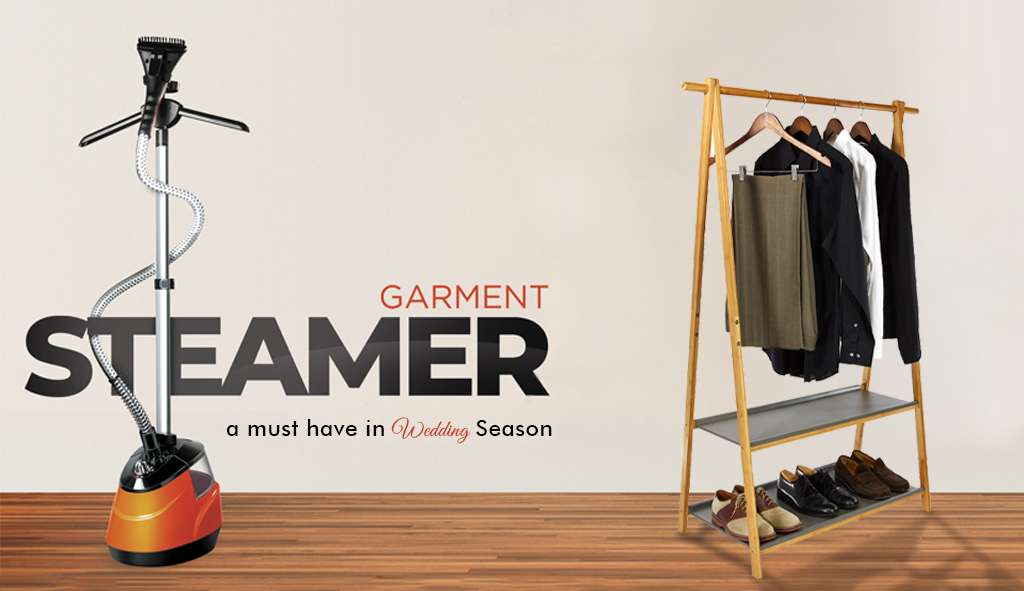A Garment Steamer is the foremost option for hassle-free ironing. When it comes to delicate clothing or items that are too large to fit on an ironing board, a garment steamer is the ideal small appliance for swiftly and conveniently removing creases. To remove wrinkles from clothing, a garment steamer employs steam. It is simple to use and does not need any additional tools, unlike an iron which needs an iron stand or a flat solid surface with a piece of cloth. You can quickly and simply eliminate wrinkles from your clothes with a garment steamer without causing any hassle. In this blog, we will discuss a lot about the garment steamer. Keep reading, if you want to know about how to select the best model for yourself and how to use it.
How to Pick the Best Garment Steamer Based on Your Needs?
You might have looking for an opportunity to upgrade your ironing tools or prepare for an upcoming wedding. In order to choose the finest garment steamer for your purposes, you must take into account a number of things to make sure you purchase the proper one. Here, step-by-step instructions are given to assist you in reaching a decision:
- Jot Down Your Needs
First of all, think about how frequently you’ll use the clothing steamer. Is it for routine usage, occasional touch-ups, or particular clothing? Take into account the fabrics you plan to steam. Make sure it’s adaptable enough for your wardrobe because different steamers work best with different types of textiles.
- Garment Steamer Types
There are two types of garment steamers available in the market. Portable handheld steamers are great for fast touch-ups and traveling. Larger, more potent standing steamers are ideal for heavy-duty steaming and diverse clothing care.
- Output and Power of Steam
In general, steamers with higher wattages function better. To effectively remove wrinkles, look for a garment steamer with a high enough steam flow rate and wattage.
- Heat-Up Period
Faster heat-up times are useful, especially when you have a limited time. Find such garment steamer models that can heat up quickly—typically in a matter of minutes.
- Size of the Water Tank
Think about the water tank’s size. Longer continuous steaming without regular refilling is possible with a bigger tank.
- Steam Options
Choose a steamer that comes with manual or digital steam settings. For best results, various textiles can need varying amounts of steam.
- Accessories & Attachments
For varied clothing cleaning, see whether the steamer includes handy accessories like brush heads, crease tools, or hangers.
- Dimensions and Portability
Think about mobility and storage. Make sure the steamer is simple to store and transfer if necessary. Getting well-pressed, wrinkle-free clothing requires proper steam iron use.
After buying a garment steamer, some people have difficulty operating it. Mostly, people use such steamers wrongly. For your ease, we will discuss using a garment steamer.
Prior to Starting
Read the Manual
Read over the manufacturer’s instructions and safety precautions in the user handbook that is included with your steam iron.
Assemble Your Materials
The clothes you wish to iron, a clean ironing board, and a steam iron are all required.
To prevent mineral accumulation in the steam vents of the iron, fill the water reservoir with distilled or demineralized water.
Preparing the Iron
Set the Iron on a Surface That Is Heat-Resistant
The iron should be plugged in and set down on a heat-resistant surface, such as an ironing board.
Choose the Proper Temperature
Based on the fabric of the clothing you’re ironing, adjust the iron’s temperature dial. Most irons feature temperature options for several types of cloth, including cotton, linen, silk, and wool.
For fragile fabrics, start with a lower temperature setting, and for heavier fabrics, raise it gradually.
Prepare the garment by Ironing
Make sure the clothing is dry and clean. The part you wish to iron should be facing up.
Steam Options
Verify the steam control setting on your iron. You might want to modify the steam amount depending on the cloth. For difficult creases, some irons offer a blast of steam setting.
Sectioned Iron
Start with a single area of the garment, such as the collar or cuffs. To eliminate wrinkles from the cloth, hold the iron over it, push the steam button to release steam, and then press the iron down onto the fabric. Following the fabric’s grain, move the iron in straight, equal strokes.
Don’t push too firmly since this might harm the cloth.
Replicate this for the Whole Garment
Section by section, work your way through the garment, paying close attention to seams and challenging spots. Use the iron’s edge to make clean lines for pleats and wrinkles. Once the entire cloth has been ironed, hang it up or fold it right away to avoid the creation of new creases.
After Ironing
Unplug and empty water after ironing:
– Switch off the iron and remove the plug from the outlet.
– To avoid mineral formation, drain any residual water from the water reservoir.
Maintenance and Cleaning
Before cleaning, let the iron cool fully. To get rid of any leftovers, you may clean the soleplate with a moist towel. You might need to routinely clean the steam vents and the anti-calc system, depending on the care recommendations for your iron.
Storage
To prevent damage, store the iron upright and properly wrap the cord. This will help your garment steamer to be prolonged for a lifetime.
Finding the best garment steamer isn’t that easy. However, Electro Gallery brings you the finest collections of garment steamers at highly affordable rates for you. Get wrinkle-free clothes that will add grace to your personality.
Contact us to learn more about your desired product now.

